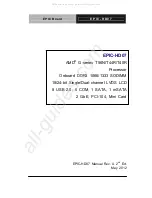
Document # 001-20559 Rev. *D
189
Digital Blocks
17.2.1.2
Counter Register Definitions
There are three 8-bit Data registers and a 2-bit Control register.
explains the meaning of these registers in the con-
text of the counter operation. Note that the descriptions of the registers are dependent on the enable/disable state of the
block. This behavior is only related to the enable bit in the Control register, not the data input that provides the counter gate
(unless otherwise noted).
Note
DR0 may only be read (to transfer DR0 data to DR2) when the block is disabled.
17.2.1.3
Dead Band Register Definitions
There are three 8-bit Data registers and a 3-bit Control register.
explains the meaning of these registers in the con-
text of dead band operation.
Note
DR0 may only be read (to transfer DR0 data to DR2) when the block is disabled.
Table 17-6. Counter Data Register Descriptions
Name
Function
Description
DR0
Count Value
Not directly readable or writeable.
During normal operation, DR0 stores the current count of a synchronous down counter.
When disabled, a write to the DR1 period register is also simultaneously loaded into DR0 from the data bus.
When disabled or the data input (counter gate) is low, a read of DR0 returns 00h to the data bus and transfers the contents
of DR0 to DR2. This register should not be read when the counter is enabled and counting.
DR1
Period
Write only register.
Data in this register sets the period of the count. The actual number of clocks counted is 1.
A period of 00h gives a constant logic high on the auxiliary output.
When disabled, a write to this register also transfers the period value directly into DR0.
When enabled, if the block frequency is 24 MHz or below, this register may be written to at any time, but the period is only
reloaded into DR0 in the clock following a TC. If the block frequency is 48 MHz, the terminal count or compare interrupt
should be used to synchronize the new period register write; otherwise, the counter could be incorrectly loaded.
DR2
Compare
Read write register.
DR2 functions as a compare register.
When enabled, the compare output is computed using the compare type (set in the function register mode bits) between
DR0 and DR2. The result of the compare is output to the primary output.
When disabled or the data input (counter gate) is low, a read of DR0 transfers the contents of DR0 into DR2.
DR2 may be written to when the function is enabled or disabled.
Table 17-7. Dead Band Register Descriptions
Name
Function
Description
DR0
Count Value
Not directly readable or writeable.
During normal operation, DR0 stores the current count of a synchronous down counter.
When disabled, a write to the DR1 period register is also simultaneously loaded into DR0 from the data bus.
When disabled, a read of DR0 returns 00h to the data bus and transfers the contents of DR0 to DR2.
DR1
Period
Write only register.
Data in this register sets the period of the dead band count. The actual number of clocks counted is 1. The mini-
mum period value is 00h, which sets a dead band time of one clock.
When disabled, a write to this register also transfers the period value directly into DR0.
When enabled, if the block frequency is 24 MHz or below, this register may be written to at any time, but the period is only
reloaded into DR0 in the clock following a terminal count (TC). If the block frequency is 48 MHz, the terminal count or com-
pare interrupt should be used to synchronize the new period register write; otherwise, the counter could be incorrectly
loaded.
DR2
Buffer
When disabled, a read of DR0 transfers the contents of DR0 into DR2.
Summary of Contents for PSoC CY8C23533
Page 4: ...Contents Overview 4 Document 001 20559 Rev D Section G Glossary 385 Index 401 ...
Page 16: ...Contents Overview 16 Document 001 20559 Rev D ...
Page 24: ...24 Document 001 20559 Rev D Section A Overview ...
Page 30: ...30 Document 001 20559 Rev D Pin Information ...
Page 54: ...54 Document 001 20559 Rev D Supervisory ROM SROM ...
Page 60: ...60 Document 001 20559 Rev D RAM Paging ...
Page 68: ...68 Document 001 20559 Rev D Interrupt Controller ...
Page 76: ...12 Document 001 20559 Rev D General Purpose IO GPIO ...
Page 82: ...18 Document 001 20559 Rev D Internal Main Oscillator IMO ...
Page 84: ...20 Document 001 20559 Rev D Internal Low Speed Oscillator ILO ...
Page 90: ...26 Document 001 20559 Rev D External Crystal Oscillator ECO ...
Page 94: ...30 Document 001 20559 Rev D Phase Locked Loop PLL ...
Page 106: ...42 Document 001 20559 Rev D Sleep and Watchdog ...
Page 228: ...164 Document 001 20559 Rev D Section D Digital System ...
Page 234: ...170 Document 001 20559 Rev D Array Digital Interconnect ADI ...
Page 278: ...214 Document 001 20559 Rev D Digital Blocks ...
Page 296: ...232 Document 001 20559 Rev D Analog Interface ...
Page 304: ...240 Document 001 20559 Rev D Analog Array ...
Page 308: ...244 Document 001 20559 Rev D Analog Input Configuration ...
Page 312: ...248 Document 001 20559 Rev D Analog Reference ...
Page 338: ...274 Document 001 20559 Rev D Section F System Resources ...
Page 354: ...290 Document 001 20559 Rev D Multiply Accumulate MAC ...
Page 374: ...310 Document 001 20559 Rev D I2C ...
Page 400: ...336 Document 001 20559 Rev D Section G Glossary ...





































